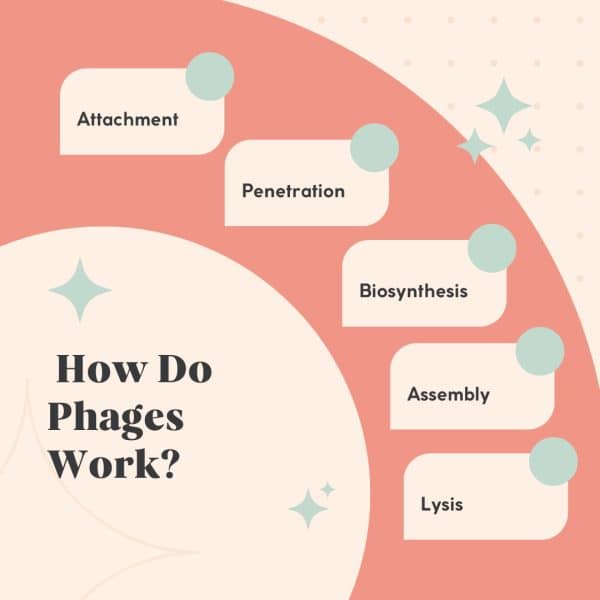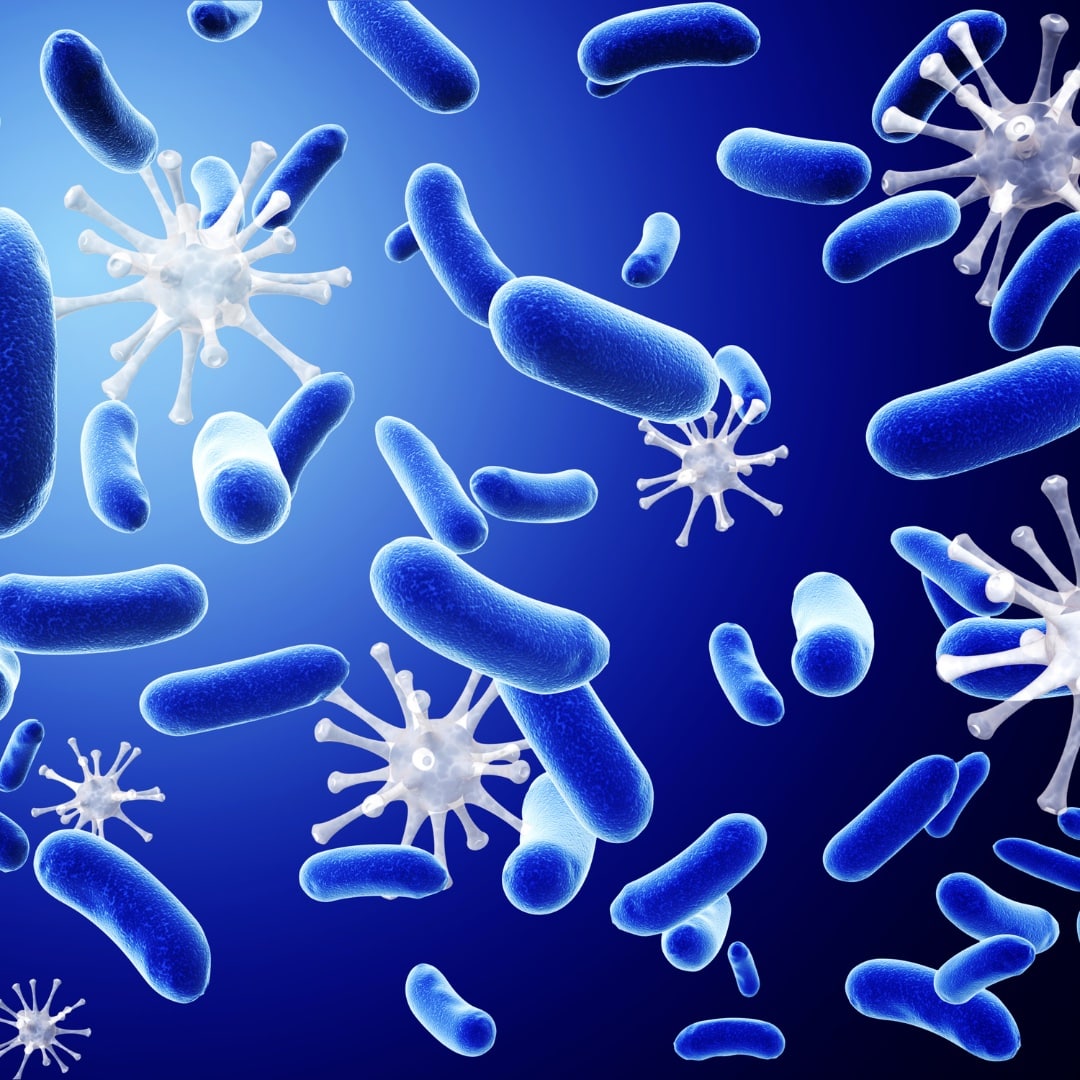In the ever-evolving world of health and nutrition, we’re constantly on the lookout for new allies in our fight against disease. One such promising ally has been quietly making waves in the scientific community: bacteriophages, or simply phages. These microscopic warriors may hold the key to tackling some of the toughest bacterial threats we face today.
In this blog post, we’ll delve into what phages are, how they work, and how you might naturally incorporate them into your body for better health. So, grab a cup of your favorite beverage, settle in, and let’s explore the fascinating world of phages together.
What Are Phages?
Bacteriophages, often just called phages, are viruses that specifically target and infect bacteria. The term “bacteriophage” literally means “bacteria eater,” which accurately describes the nature of these microscopic organisms. These remarkable viruses are incredibly diverse and can be found wherever bacteria exist – from the ocean depths to the soil beneath our feet, and even inside our own bodies.
Phages are typically composed of a protein coat that encases their genetic material, which can be either DNA or RNA. This structure allows them to attach to specific bacteria, inject their genetic material, and essentially hijack the bacterial cell’s machinery to reproduce themselves. In doing so, they often destroy the host bacterium, effectively neutralizing the threat it poses.

How Do Phages Work?
Bacteriophages operate through a process called the lytic cycle. Here’s a step-by-step breakdown of how they work:
1. Attachment: A phage finds its target bacterium and attaches to it using specialized proteins on its surface. This step is highly specific, as each phage is adapted to recognize particular bacterial strains.
2. Penetration: Once attached, the phage injects its genetic material into the bacterial cell. This is where the magic begins.
3. Biosynthesis: The phage’s genetic material takes control of the bacterium’s cellular machinery, redirecting it to produce new phage components instead of the bacterium’s usual functions.
4. Assembly: The newly created phage components are assembled into complete phage particles within the bacterial cell.
5. Lysis: Finally, the bacterial cell bursts open, releasing the new phage particles to seek out and infect more bacteria. This not only eliminates the host bacterium but also amplifies the phage population, ready to tackle more bacterial foes.
Why Phages Matter in Disease-Fighting
The growing interest in good viruses stems from their potential to address one of the most pressing challenges in modern medicine: antibiotic resistance. As bacteria evolve and become resistant to antibiotics, our ability to treat bacterial infections diminishes. This is where they come into play.
Phages offer a few distinct advantages over traditional antibiotics:
–Specificity: Unlike broad-spectrum antibiotics, which can kill beneficial and harmful bacteria, phages are highly specific. They target only particular strains of bacteria, leaving the rest of the microbiome intact.
– Evolutionary Adaptability: They can evolve alongside bacteria, potentially keeping up with bacterial mutations that lead to antibiotic resistance.
– Natural Presence: Phages are already present in various environments, including our bodies, which suggests they could be harnessed more naturally and less invasively than some traditional treatments.
How Do You Get Phages in Your Body?
Phages are naturally occurring and can enter the body through a variety of means:
1. Diet: Many foods naturally contain them.
- Yogurt, Sauerkraut, and Kimchi: These fermented foods are well known for their probiotic content, which helps balance the gut microbiome. What’s less discussed is that these foods also come with bacteriophages that can help maintain microbial equilibrium. They act as a natural check, ensuring that populations of specific bacterial strains don’t grow unchecked, thereby promoting a balanced gut environment.
- Other Sources: Fresh fruits and vegetables that are grown in soil often carry a variety of harmless phages. Consuming these foods, especially when they are minimally processed, can introduce a spectrum of phages into the digestive system.
2. Environment: Phages are ubiquitous in the environment. They are present in:
- Soil and Water: Outdoor activities such as gardening, swimming in natural bodies of water, or simply spending time in nature can expose individuals to a wide variety of these little fellows. Soil, in particular, is a rich source of phages that interact with both plant and human-associated bacterial communities.
- Airborne Phages: Research has shown that phages can also be airborne, making them part of the microbial environment we breathe in daily. While this aspect is still being studied, exposure to environmental phages may contribute to microbial diversity within our respiratory and digestive systems.
3. Probiotic Supplements: Some probiotic supplements are beginning to incorporate phages to enhance their effectiveness.
- Enhanced Probiotic Action: Some supplements now include bacteriophages as an adjunct to traditional probiotics. These phage-infused supplements aim to selectively reduce harmful bacteria while allowing beneficial strains to thrive. This selective approach may help prevent the overgrowth of pathogenic bacteria, enhancing the overall effectiveness of the probiotic.
- Potential Benefits: By targeting specific bacterial strains, phage-containing probiotics could provide targeted support for individuals facing particular gut health challenges, such as recurrent infections or imbalances related to conditions like irritable bowel syndrome (IBS).
4. Phage Therapy: While still largely in the experimental stages in many parts of the world, phage therapy involves the direct application of phages to treat bacterial infections.
- A Promising Alternative to Antibiotics: In an age where antibiotic resistance is a growing concern, phage therapy offers a potential solution. Phages are highly specific, meaning they can target and eliminate particular strains of bacteria without disrupting the rest of the body’s microbiome. This specificity minimizes the collateral damage that broad-spectrum antibiotics can cause.
- Applications and Research: While phage therapy has been used in countries like Russia and Georgia for decades, it is still considered experimental in many other parts of the world. However, recent cases, such as treating multidrug-resistant infections, have sparked global interest. Clinical trials are exploring its use in treating chronic and life-threatening infections that do not respond to conventional antibiotics.
- Future of Personalized Medicine: As the understanding of bacteriophages and their mechanisms deepens, the potential for phage therapy to become a tailored treatment option grows. This could mean phages are selected or engineered to target specific bacterial strains in an individual, providing a highly personalized medical approach.
The Future of Phages in Health and Nutrition
As research progresses, the potential applications of phages in health and nutrition continue to expand. Scientists are exploring their use not only in treating infections but also in agriculture to protect crops, and even in food safety to reduce harmful bacteria in food products.
While phage therapy and phage-based products are still under rigorous study, the future looks promising. The idea of using naturally occurring viruses to combat bacterial threats aligns with a growing interest in more natural and sustainable approaches to health.
Conclusion
Phages represent a fascinating and potentially game-changing tool in our arsenal against disease. Their natural specificity, adaptability, and presence in the environment make them an attractive alternative or complement to traditional antibiotics. As we continue to learn more about these microscopic allies, we may find that they offer a vital key to maintaining health in an increasingly antibiotic-resistant world.
Incorporating phages into your life, whether through diet, environment, or future therapies, could be a step towards a healthier, more resilient you. Stay informed, stay curious, and, as always, consult with healthcare professionals before making significant changes to your health regimen.
Thank you for joining me on this journey into the world of phages. I hope this article leaves you with a greater appreciation for the tiny warriors who might just be the heroes we need in our fight against disease. If you have any questions or would like to share your thoughts, feel free to leave a comment below. I love hearing from you!
***Disclaimer: This post is for informational purposes only and should not be construed as medical advice***



